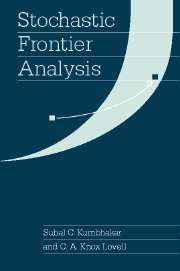Book contents
- Frontmatter
- Contents
- Preface
- 1 Introduction
- 2 Analytical Foundations
- 3 The Estimation of Technical Efficiency
- 4 The Estimation and Decomposition of Cost Efficiency
- 5 The Estimation and Decomposition of Profit Efficiency
- 6 The Shadow Price Approach to the Estimation and Decomposition of Economic Efficiency
- 7 Incorporating Exogenous Influences on Efficiency
- 8 The Estimation of Efficiency Change and Productivity Change
- References
- Author Index
- Subject Index
5 - The Estimation and Decomposition of Profit Efficiency
Published online by Cambridge University Press: 05 June 2012
- Frontmatter
- Contents
- Preface
- 1 Introduction
- 2 Analytical Foundations
- 3 The Estimation of Technical Efficiency
- 4 The Estimation and Decomposition of Cost Efficiency
- 5 The Estimation and Decomposition of Profit Efficiency
- 6 The Shadow Price Approach to the Estimation and Decomposition of Economic Efficiency
- 7 Incorporating Exogenous Influences on Efficiency
- 8 The Estimation of Efficiency Change and Productivity Change
- References
- Author Index
- Subject Index
Summary
INTRODUCTION
In Chapter 4 our efficiency analysis was based on the assumption that producers face exogenously determined input prices and output quantities and attempt to allocate inputs so as to minimize the cost of producing their outputs. Under this assumption inputs, but not outputs, are determined endogenously. While a cost minimization objective is undoubtedly appropriate in some environments, it can be argued that in other environments it is not sufficiently stringent, because for many producers the ultimate objective is to maximize profit. In such an environment the assumption is that producers face exogenously determined input prices and output prices and attempt to allocate inputs and outputs so as to maximize profit. Under this assumption both inputs and outputs are determined endogenously. The main difference between the two frameworks is that when producers attempt to maximize profit, they have to decide not only how much of various inputs to use (which is the case for producers attempting to minimize cost), but also how much of various outputs to produce. In other words, the issue is not just one of finding the cost-minimizing input combination required to produce a given bundle of outputs, but also one of finding the revenuemaximizing output combination as well, and so the number of decision variables increases from N to M + N. In this chapter our focus is on efficiency measurement when the objective of producers is to maximize profit.
- Type
- Chapter
- Information
- Stochastic Frontier Analysis , pp. 184 - 215Publisher: Cambridge University PressPrint publication year: 2000



